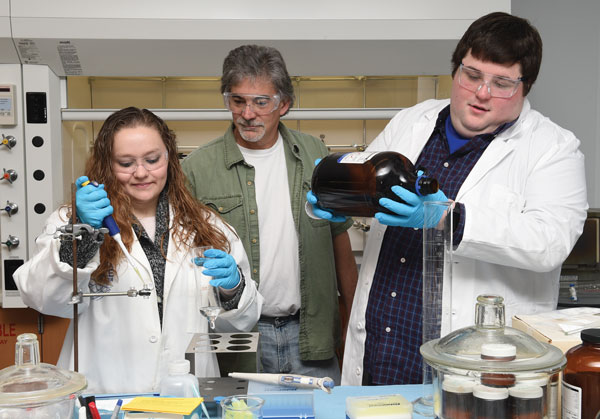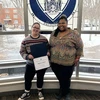
Michael Milligan has taught Chemistry and Biochemistry at Fredonia for 22 years, and every step of the way he’s been engaged in Great Lakes research funded by grants that, at last count, top $17 million.
“Ever since I was young, I have had a scientific interest in the workings and intricacies of the global environment,” said Dr. Milligan — a Fredonia alumnus (Class of ’85) who examined how chemicals cycle through and distribute themselves in the environment as a dual Chemistry and Chemical Engineering major.
Working for the New York Department of Environmental Conservation spurred Milligan’s interest in synthetic chemicals that are introduced into the water, air, soil and sediments. There he assessed the hazards and toxicities of hundreds of chemicals used in commerce.
Today, Milligan serves on a research team of five university scientists that recently received its third Great Lakes Fish Monitoring and Surveillance Program (GLFMSP) grant, valued at $6.75 million, to significantly expand their analysis of Great Lakes fish.
The program is dedicated to monitoring “legacy,” or contaminants no longer being manufactured that may remain in the environment, and conducting surveillance of “emerging contaminants of concern,” which are potential pollutants that may be released into the environment, Milligan explained.
The initial $2.75 million awarded in 2005 allowed the team to analyze top predator fish for a suite of chemicals, such as polychlorinated biphenyls (PCBs) and chlorine-base pesticides that include DDT. Researchers added components to the study in the second funding cycle in 2010. The third cycle that began in October 2015 expands the existing database of emerging chemicals already identified in fish tissue, and then adds research partners from other universities to augment their expertise in specific aspects. The flow of contaminants throughout the food web will also be studied in each lake.
“We analyze the sediments, plankton (microscopic animals and plants), forage fish and top predator fish — particularly lake trout — to try to understand and predict how these contaminants march their way up the food web,” Milligan explained.
Upon returning to Fredonia in 1993 to develop its Environmental Chemistry research program, Milligan joined the New York State Great Lakes Research Consortium, which brings together New York scientists and engineers interested in Great Lakes research. Its 400 members research every facet of Great Lakes science.
Through this organization, comprised of 18 colleges and universities in New York and nine affiliate campuses in Ontario, Milligan met many researchers and became part of a group that began submitting small research proposals to generate preliminary data that they hoped would lead to more extensive research proposals.
Milligan and colleagues from Clarkson University and SUNY Oswego subsequently received a two-year, $375,000 grant from the New York State Energy and Research Development Authority to study the effects of pollution derived from coal-fired power plants. A three-year, $400,000 grant from the U.S. Environmental Protection Agency to study persistent bio-accumulative toxic pollutants in the Great Lakes followed in 2002.
Milligan says research compiled during the first two GLFMSP grants revealed a decrease in the levels of known contaminants in the Great Lakes, yet he cautions that a suite of new emerging contaminants is currently released into the Great Lakes, and undoubtedly into the global environment. What the risks these new compounds — chemically exotic fire retardants, pharmaceuticals, newly designed pesticides, and more — are to wildlife and human health are unknown, he said.
More than a dozen students have worked alongside Milligan as paid research assistants, and other students have served on spin-off projects, during the last 10 years.
“Like any other undergraduate research experience, the students are afforded the opportunity to work on real-life problems where the answers to the questions we are trying to answer are not known,” Milligan explained.
Collaborating with Milligan on GLFMSP research are Drs. Phil Hopke, who began his academic career in Fredonia’s chemistry department, Thomas Holsen and Bernard Crimmins, all of Clarkson University, and James Pagano of SUNY Oswego.



